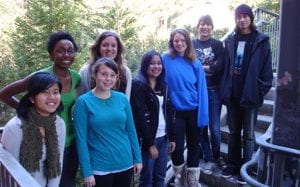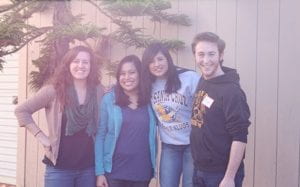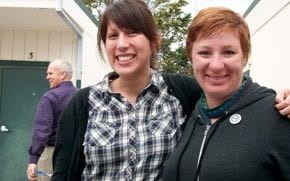 Ly, Rahsheka, Lisa, Terri, Irene, Amy, Christina, & Martin (Not pictured: Monica)
Ly, Rahsheka, Lisa, Terri, Irene, Amy, Christina, & Martin (Not pictured: Monica) Terri, Irene, Maria, and Ryan (Amy not pictured) are the undergraduate team for the 4th and 5th grade after-school program.
Terri, Irene, Maria, and Ryan (Amy not pictured) are the undergraduate team for the 4th and 5th grade after-school program. Christina & Erin are photographed by a student in response to the question, “What’s something you wish there was more of in your community?”
Christina & Erin are photographed by a student in response to the question, “What’s something you wish there was more of in your community?”
The Community Psychology Research & Action Team (CPRAT) engages in participatory action research in a local community. The team has been working in the area since 2007. In all cases, the research questions and plans are jointly determined with community collaborators, but are always related to community-based empowerment, or groups with historically little power gaining control over the resources that affect their lives.
Current and Recent Projects
- Student Veteran Photovoice Project
- Service Learning as a Way to Shift University Campus Culture
- Change 4 Good
- Viva Live Oak
Student veteran photovoice project
Student veteran photovoice project: Capturing, enhancing, and increasing student veteran visibility and engagement on campus
Campus-wide data indicate that student veterans are less engaged in the campus community than their non-veteran student peers. This is troubling because the literature indicates that campus engagement is correlated with student success. This participatory action research project works with student veterans to examine if engagement rates are lower, or if student veterans have high engagement rates on the campus, but their engagement happens in ways that are not captured in the typical questions asked on most college campuses. Having a better understanding of what student veteran campus engagement looks like opens up a broader community dialogue around engagement. Moreover, the student veteran population on the UC Santa Cruz campus is relatively small. This can lead to low visibility and the employment of stereotypes about veterans. Creating spaces for student veterans to tell stories that show their multiple identities and “complex personhood” can help others on campus have a more complete picture of student veterans, which will help reduce stereotypes.
Service-learning as a way to shift university campus culture
Graduate student researchers: David Gordon, Xafsa Ciise, Stephanie Tam Rosas, Christine Rosales, and Miguel Lopezzi
Hispanic Serving Institutions (HSIs) of higher education have a social justice mission to serve the students who attend the university. HSIs tend to have a plurality of students of color and first generation to college students. This research project examines how service-learning courses serve BIPOC and first-gen students, with an emphasis on Latinx students. The project also examines if service-learning courses can serve as a cultural bridge between the university and home communities, thus working against hegemonic structures of the university (e.g., whiteness, upper middle class assumptions of success).
Change 4 Good
Since 2007, fourth and fifth graders (hereafter, researchers) from a local elementary school have been collaborating with CPRAT, using participatory action research to create positive changes in their school. Through artistic expression and discussions around community, education and diversity, researchers created the “We Are Powerful” mural during the summer of 2009. Additional mural support was provided by art4change, housed at Gavilan College. The mural is an example of the changes these researchers are making in their school and community. Change 4 Good researchers then assessed the “We Are Powerful” mural to see if it addressed their original problem definition. They determined that other students did not feel connected to the mural so they conducted focus groups to incorporate student, school staff, and community stories about making a change in the community. They designed a mural based on these stories and in the summer of 2012, they painted the mural “Maplewood Stories.” The researchers then surveyed the school and community about that mural and learned that teachers felt least connected to the image representing “struggle.” This was so important to the researchers that they decided to conduct more focus groups asking about a more unifying theme: people’s hopes and dreams for the school and the community. Over the summer of 2015, the researchers painted the mural “Hopes and Dreams of the Maplewood Community,” which was based on responses from a third set of focus groups. In 2016 the researchers surveyed the school and community to learn if the mural represented the community’s hopes and dreams. Researchers continue to meet once a week to identify issues in their school and community as they determine what to research and act upon.
Viva Live Oak
Graduate student coordinator: Jesica Fernández
The collaboration was a "photovoice project" that included residents taking pictures of their neighborhoods, writing narratives about their pictures, having conversations, and developing themes that describe their neighborhood. Based on their pictures, they determined their themes to be: historical and ecological preservation, community pride, and social justice. This 7-week examination turned into a year-long project, as residents decided to continue meeting so that they could plan actions to take within their community, based on the themes of their pictures. Some actions were the creation of a calendar that included historical information about their community, and community exhibitions of their photographs and narratives at the library, farmer's market, and the county building. The goals were to increase the sense of community for residents and the facilitation of a stronger place identity, which our participants viewed as important to effectively engage in other forms of community-based action.